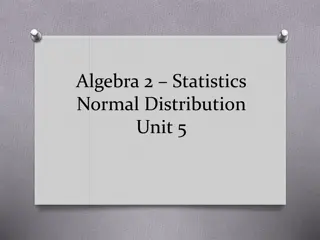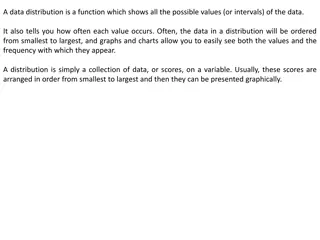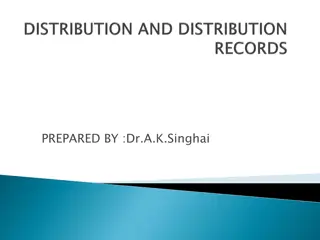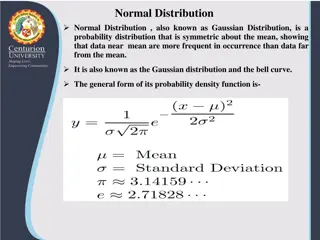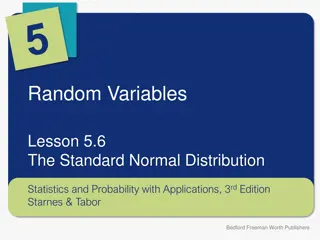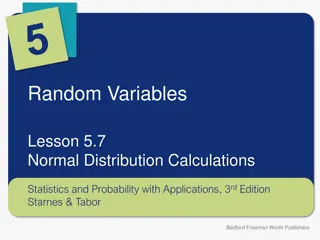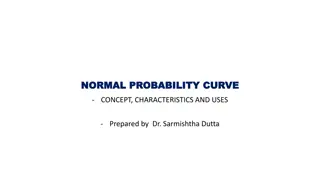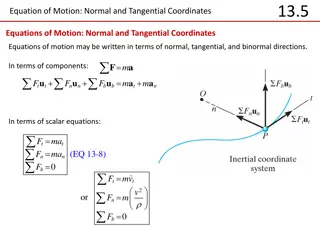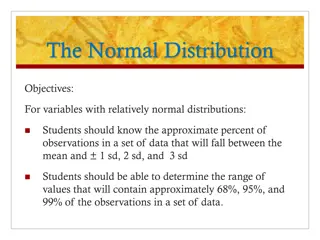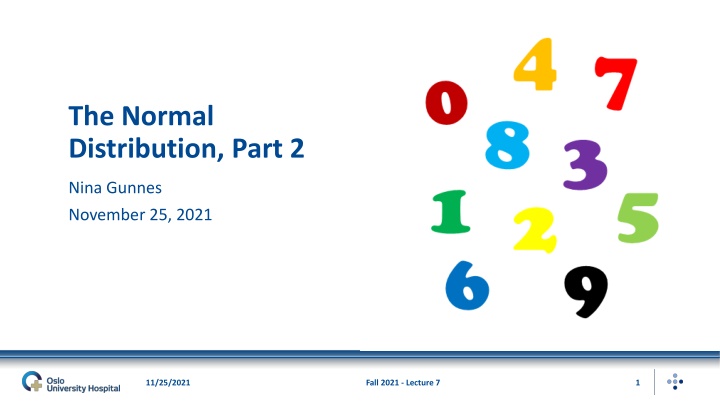
Normal Distribution and Central Limit Theorem
Delve into the concepts of normal distribution, central limit theorem, and the normal approximation to the binomial distribution. Explore how sums of random variables become approximately normally distributed, the central role of the binomial distribution, and the simplification that the normal distribution offers in probability calculations.
Download Presentation

Please find below an Image/Link to download the presentation.
The content on the website is provided AS IS for your information and personal use only. It may not be sold, licensed, or shared on other websites without obtaining consent from the author. If you encounter any issues during the download, it is possible that the publisher has removed the file from their server.
You are allowed to download the files provided on this website for personal or commercial use, subject to the condition that they are used lawfully. All files are the property of their respective owners.
The content on the website is provided AS IS for your information and personal use only. It may not be sold, licensed, or shared on other websites without obtaining consent from the author.
E N D
Presentation Transcript
The Normal Distribution, Part 2 Nina Gunnes November 25, 2021 11/25/2021 Fall 2021 - Lecture 7 1
Central limit theorem Very important theorem in statistics Sum of many random variables approximately normally distributed All original variables independent of each other None of the original variables with dominant influence on the sum Original variables not necessarily normally distributed themselves Sample mean normally distributed due to the central limit theorem Sample of i.i.d. variables with mean ? and standard deviation ? ? = ? ?=1 ??~N ?, ? 1 ? ? 11/25/2021 Fall 2021 - Lecture 7 2
Central limit theorem, cont. Height approximately normally distributed Influenced by genetics and factors related to prenatal life and childhood Sum of many (more or less) independent factors Applying to only one sex and one ethnicity at a time (why?) https://pixabay.com/illustrations/man-icon-characters-toilet-male-1332780/ https://pixabay.com/illustrations/woman-icon-characters-toilet-1332779/ 11/25/2021 Fall 2021 - Lecture 7 3
Normal approximation to binomial Binomial distribution playing a central role in many settings ? ? = ? = ?! ? ???1 ?? ?, where ? = 0,1, ,? and ? Binomial probabilities sometimes hard to calculate ? ? ? = ? ? = ? + ? ? = ? + 1 + + ? ? = ? = ?=? Binomial distribution approaching normal distribution when ? is large Mean (i.e., expectation or expected value): E ? = ? = ?? Standard deviation: SD ? = ? = ?= ?! ? ? ! ? ? ? = ? ?? 1 ? 11/25/2021 Fall 2021 - Lecture 7 4
Normal approximation to binomial, cont. 11/25/2021 Fall 2021 - Lecture 7 5
Normal approximation to binomial, cont. Approximation improving as the number of trials increases Expected number of successes: ?? 5 Expected number of failures: ? 1 ? 5 Probability calculations simplified substantially Normal distribution easier to use than binomial distribution Result following from the central limit theorem Binomial variable ? regarded as a sum of independent indicator variables The larger ? (number of trials), the more terms in the sum 11/25/2021 Fall 2021 - Lecture 7 6
Example (Aalen et al., 2006) Binomial experiment of ? = 20 childbirths Probability of a boy for each birth: ? = 0.514 ?: number of boys; ?~Bin ?,? Probability of more than 14 boys? ? ? > 14 = ? ? = 15 + ? ? = 16 + + ? ? = 20 Reasonably large ? to use the normal distribution instead? Expected number of boys ( successes ): ?? = 20 0.514 = 10.28 5 Expected number of girls ( failures ): ? 1 ? = 20 0.486 = 9.72 5 11/25/2021 Fall 2021 - Lecture 7 7
Example (Aalen et al., 2006), cont. Normal approximation to binomial distribution: ?~N ?,? Mean: ? = ?? = 20 0.514 = 10.28 Standard deviation: ? = ?? 1 ? = Standardization of ?: ? = ? ? ?~N 0,1 Using the normal distribution for the probability calculation ? ? > 14 = 1 ? ? 14 1 ? ? 14 10.28 1 0.9515 = 0.0485 = 4.9% 20 0.514 0.486 = 2.24 ? = ? 10.28 2.24 = 1 ? ? 1.66 = 2.24 11/25/2021 Fall 2021 - Lecture 7 8
Continuity correction Improving the normal approximation of the binomial distribution Especially important when ? is small Every value ? of the binomial distribution corresponding to a bar Height of bar equal to ? ? = ? Bar centered at ?, with horizontal bounds ranging from ? 0.5 to ? + 0.5 Including the entire bar of ? not just the lower (or upper) half Approximation of a discrete distribution by a continuous distribution ? ? ? + 0.5 (or ? ? ? 0.5 ) instead of ? ? ? (or ? ? ? ) 11/25/2021 Fall 2021 - Lecture 7 9
Continuity correction, cont. 11/25/2021 Fall 2021 - Lecture 7 10
Continuity correction, cont. Calculating the probability of more than 14 boys of 20 childbirths ? ? > 14 1 ? ? 14.5 10.28 2.24 0.0301 = 3.0% Correct binomial probability: ? ? > 14 = 2.8% Result with continuity correction closer to the correct result than without = 1 ? ? 1.88 = 1 0.9699 = 11/25/2021 Fall 2021 - Lecture 7 11
Example (Aalen et al., 2006) Binomial experiment of ? = 60000 annual childbirths in Norway Probability of a boy for each birth: ? = 0.514 ?: number of boys ? binomially distributed: ?~Bin ?,? Normal approximation to binomial ? = E ? = ?? = 60000 0.514 = 30840 ? = SD ? = ?? 1 ? = 60000 0.514 0.486 = 122 ?~N ?,? ? = ? ? ? = ? 30840 122~N 0,1 11/25/2021 Fall 2021 - Lecture 7 12
Example (Aalen et al., 2006), cont. Probability of at least as many girls as boys? Binomial probability very complicated to calculate Clear advantage of using the normal approximation ? ? 30000 ? ? 30000 30840 No need for continuity correction due to large ? Highly unlikely that more girls than boys are born in Norway per year Expected excess of boys: ?? ? ?? = 30840 29160 = 1680 = ? ? 6.89 < 0.0001 122 11/25/2021 Fall 2021 - Lecture 7 13
References Aalen OO, Frigessi A, Moger TA, Scheel I, Skovlund E, Veier d MB. 2006. Statistiske metoder i medisin og helsefag. Oslo: Gyldendal akademisk. 11/25/2021 Fall 2021 - Lecture 7 14



